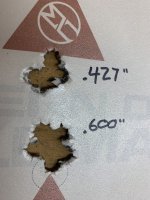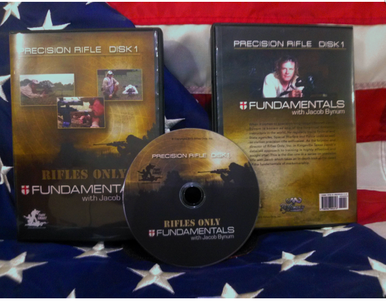Been reloading .308 for a year, upgrading rifle and reloading components one piece at a time, pursuing consistent 1 MOA accuracy. Have achieved good to great results on occasion, but the only thing consistent is that my loads consistently turn to shit the next day.

Shot these two groups recently, thinking I had it. Ive thought that before. There were 20 shots total, the other two groups a little larger but still under 1”. SD 8. ES 12. 20 shots. Avg velocity velocity 2640.
That was the last of the Varget jug. New lot runs about 40fps faster. Tried that, then went down from 42.8 to 42.2gn. Velocity was all over the place. Avg was close to targeted 2740fps. Groups were shit.
Well, I have 100 Lapua cases and maybe 400 Federal cases. Federal isn’t all the same lot and hasn’t been sorted by volume or weight. Maybe the universe won’t let me get away with that and wants me to get more Lapua.
Today, it was Lapua brass, 42.2gn Varget, SMK 168, CCI 210, and a pile of shit. ES 50. SD 18. WTF?
Compared that to what I thought was a good load from a few months ago with Berger 168’s, left over from a match. It wasn’t good. Big groups and big numbers.
Rifle is Remington 700 action, Criterion 24” light varmint, MDT Oryx, Nightforce NX8 4-32.
Reloading equipment is old RCBS rockchucker, charge master light, Redding full length sizing die set to bump shoulder .002”, Forster ultra micrometer seating die, and a 21st century expander mandrel. I trim every time with a Lee deluxe trimmer, if for nothing else, to chamfer the inner neck. On Federal brass it leaves a weird flange around the mouth of the case, which was suspect, and couldn’t be cleaned up with a hand deburring tool. On Lapua brass, no noticeable flange or weirdness around the mouth.
Recently started trying to anneal by hand, rotating case necks under flame until too hot for my fingers. It’s probably inconsistent and may be doing more harm than good. Neck tension and seating force feel much more consistent since using mandrel, Forster seater and annealing.
I suspect the Rockchucker is inadequate, but can’t imagine it’s the main problem. Haven’t checked concentricity. Why buy a gauge only to tell me my process is fucked? I dunno. Had faith the new Chargemaster was accurate, but will need to check that, too. My other scale is a super old Rcbs digital, so not sure how much that will tell me, if anything.
Gonna get a few hundred more Lapua brass to eliminate that variable. Haven’t tried all the bullets or all the powders. Haven’t tried all the expander mandrels. .3065 worked better than .306”.
If there’s anything obvious I could be doing better, feel free to point it out. I’m thinking a few imperfections are adding up to a big imperfection. Then there’s the human factor. I’m not a perfect shot but want my rifle to shoot better than me, and it doesn’t.

Shot these two groups recently, thinking I had it. Ive thought that before. There were 20 shots total, the other two groups a little larger but still under 1”. SD 8. ES 12. 20 shots. Avg velocity velocity 2640.
That was the last of the Varget jug. New lot runs about 40fps faster. Tried that, then went down from 42.8 to 42.2gn. Velocity was all over the place. Avg was close to targeted 2740fps. Groups were shit.
Well, I have 100 Lapua cases and maybe 400 Federal cases. Federal isn’t all the same lot and hasn’t been sorted by volume or weight. Maybe the universe won’t let me get away with that and wants me to get more Lapua.
Today, it was Lapua brass, 42.2gn Varget, SMK 168, CCI 210, and a pile of shit. ES 50. SD 18. WTF?
Compared that to what I thought was a good load from a few months ago with Berger 168’s, left over from a match. It wasn’t good. Big groups and big numbers.
Rifle is Remington 700 action, Criterion 24” light varmint, MDT Oryx, Nightforce NX8 4-32.
Reloading equipment is old RCBS rockchucker, charge master light, Redding full length sizing die set to bump shoulder .002”, Forster ultra micrometer seating die, and a 21st century expander mandrel. I trim every time with a Lee deluxe trimmer, if for nothing else, to chamfer the inner neck. On Federal brass it leaves a weird flange around the mouth of the case, which was suspect, and couldn’t be cleaned up with a hand deburring tool. On Lapua brass, no noticeable flange or weirdness around the mouth.
Recently started trying to anneal by hand, rotating case necks under flame until too hot for my fingers. It’s probably inconsistent and may be doing more harm than good. Neck tension and seating force feel much more consistent since using mandrel, Forster seater and annealing.
I suspect the Rockchucker is inadequate, but can’t imagine it’s the main problem. Haven’t checked concentricity. Why buy a gauge only to tell me my process is fucked? I dunno. Had faith the new Chargemaster was accurate, but will need to check that, too. My other scale is a super old Rcbs digital, so not sure how much that will tell me, if anything.
Gonna get a few hundred more Lapua brass to eliminate that variable. Haven’t tried all the bullets or all the powders. Haven’t tried all the expander mandrels. .3065 worked better than .306”.
If there’s anything obvious I could be doing better, feel free to point it out. I’m thinking a few imperfections are adding up to a big imperfection. Then there’s the human factor. I’m not a perfect shot but want my rifle to shoot better than me, and it doesn’t.
Last edited:



